






Horse health:
P. 7 Puncture Wounds: Recognize and Treat
P. 9 Equine Summer Allergies
Young Riders:
P. 11 Jayven Kilgore: Riding the Difficult Horses
Behind the Business:
P. 13 One Design Led to Another Greener
Pastures:
P. 14 Horse Fencing 101
P. 15 Pasture Mud Management
Focus: Summer Horse Care
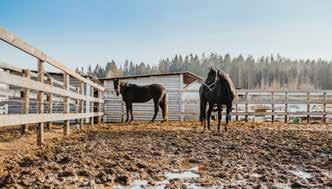
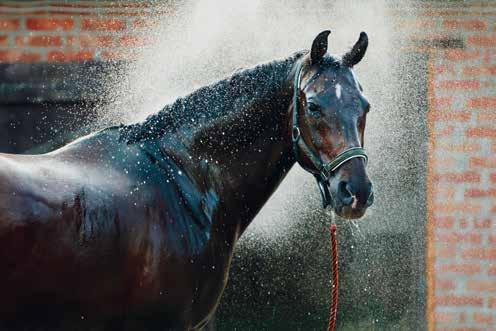
P. 16 Summer Hoof Care
P. 17 Warming Up and Cooling Down in Hot Weather
P. 18 Fly Control
P. 19 Disaster Preparedness: For the Equestrian
P. 20 Keeping your Horse Comfortable during Extreme Heat
P. 21 Woodstock Ghost Rider’s 4-H Club take on Western Region 4-H Horse Judging Contest
P. 22 An American Wins the Land Rover Ken tucky Three Day Event for first time in 15 Years
P. 24 Memphis Eventing’s First 2023 Combined Training Show at North Grove Equestrian Park

P. 25 Volunteer Ranch Horse Eggstravaganza
P. 26 Volunteer Ranch Horse Eggstravaganza
Markeplace
P. 28-29
Calendar
P. 30
One the Cover:
the Land Rover Kentucky
For a limited time, come experience the emission-free performance and quiet power of the Solectrac e25 compact all-electric tractor. Blending clean energy with modern technology, the e25 provides maximum torque at zero RPMs—so you get all the power and performance you need, with a working runtime up to 6 hours. Enjoy lower overall costs than diesel—no expensive fuel to buy, less maintenance with one moving part in the motor, and no engine oils or DPF to replace. For full specs visit Solectrac.com

May 2023
Volume 33 | Number 9
Publisher & Owner
Lauren Pigford Abbott labbott@mshorsereview.com 901- 279- 4634
Office & Accounts Manager
Andrea Winfrey andrea@mshorsereview.com 901-867-1755
Advertising & Marketing info@mshorsereview.com

Contributing Writers & Photographers
Alicia Johnson
Grace Netter
Juliana Chapman
Michele Harn
Gary Cox
Paul Nolte
Main Office: P.O. Box 594 Arlington, TN 38002 901-867-1755
Happy Mother’s Day to all the women in my life. I want to make sure that it is clear that I am recognizing ALL women, even those who do not have human children, but who care for one, two, or even a barn full of four legged fur-children! You are just as much mothers as your friends who get extra hugs and kisses from their partners and human kiddos on Mother’s Day.
I recently turned 40 and lived life for 39 years without having a child. I might be mistaken, but throughout my entire adult life I found that fellow female friends with human children viewed me differently because I did not have children. Maybe they envied me as a single woman who had the “freedom” to do whatever I liked. Once I was married, I felt my “mom friends” thought I would finally be fulfilled as a woman once I had a child of my own. Again, my perception may have been wrong, but that’s how I felt which is what matters most.
It felt as if I was not a part of this mom club where other women could connect and discuss how exhausted they were for managing their households: keeping kids fed, clean, engaged with school, sports, and how to be decent human beings. Oftentimes my mom friends would say to me, “You’ll understand when you have kids.”
As encouraging, loving and supporting all my friends are and were, especially before I had a child, I know there was no belittling or negativity meant by that statement. But I always laughed to myself and thought I didn’t need to have a human child to understand, I had horses!
I didn’t get married until I was 37. I started working when I was a Junior in high school. I worked all the way through college. I paid off my student loans, and I lived alone, without a roommate, post college once I could afford it. I paid my own bills and my own way. I didn’t have the luxury to lean on my parents to help me out if I had a slow commission month. With the challenges all young people face while trying to figure out how to pay for today’s expenses I also had my horse, Gage. My sister, Ashlee, gifted him to me as a graduation gift, but I had to work to keep him. I worked a full time job, a photography and art side hustle, and I fed horses and cleaned stalls to make sure his board was covered every month. And sometimes, three different ways to bring in income wasn’t always enough. I had to make sacrifices and went without a lot of “extras.”
When I found more stability and moved to a house with five acres and a barn I brought Gage home with me. Not only did I need to make sure every bill was paid every month, I also had to manage my horses’ daily care, find time to ride, and when I could trailer over for jump lessons. I was running from the time the sun came up, until 9, sometimes 10 pm at night. I was exhausted!
So why am I recapping the past, and how exactly does it relate to Mother’s Day? Easy! I was running ragged because my horses were my entire world. They fulfilled me in a way that I could not and cannot explain. They were my babies! And they still are!
I am a mom now, and while my husband comes first and our daughter comes right after our relationship, I don’t feel different. I don’t feel more accomplished. I don’t feel more exhausted. I learned a long time ago that I was a mom. My horses and dogs and cats taught me how to be a mother and a caregiver. My animals taught me how to hustle and do everything in my power to make sure they had the best life possible. They brought out my motherly instincts and refined them well before I had a daughter of my own.
Sometimes on social media I see other women comment that being a “fur mom” is nothing like being a “real mom.” To those who think that and have said that, YOU ARE WRONG!
My lady friends who do not have children, but manage 1200 lb animals, you are more than worthy of being considered a mom. You are the strongest group of women I know, and you do not have to have a human child to earn that badge. I see you struggle, I see you’re exhausted, I see you don’t have time for yourself. I see you constantly questioning yourselves and asking “what is it all for?” I see you fight against a stigma that you are not enough as a woman without having a child. Guess what, you are!
So today I celebrate all women, those with human children, and those without, but especially the women who are Horse Moms!
Published by Ford Abbott Media, LLC
 Lauren Pigford Abbott Publisher & Owner
Lauren Pigford Abbott Publisher & Owner

Puncture wounds can be as difficult to treat as they are to diagnose. A puncture wound is defined as an injury that is caused by an object puncturing the skin and causing a small hole that penetrates beyond the surface of the skin. What makes puncture wounds difficult to treat at times is the depth of the wound in relation to the opening. In horses, puncture wounds in the hoof are most often caused by stepping on a sharp object or on the body via various accidents. Often the wound can heal on the surface while foreign
material and infection remain under the closed entry of the original wound. On the skin, it can present as an oozing sore that doesn’t seem to heal. In the hoof it can be lameness that doesn’t isolate well to a particular area. Your horse’s vet has the tools and expertise to sort through the signs, make a diagnosis, and prescribe the appropriate treatment.
According to a news release on the Oklahoma State University website from Nov 15, 2021, “If a puncture wound is suspected, radiographs may be used to determine the location and depth of the injury. The veterinarian will place a metal probe into the wound tract and take radiographs of the foot. By doing this the veterinarian can better determine the location and depth of the puncture, as the metal probe will be seen as a bright white object on the radiographs.” Depending on the depth of the wound tract, it may be necessary for your vet to do extensive debridement of the foot. Some horses even need a special shoe to support the foot as it grows out during the healing process.
Puncture wounds to the skin can be a little easier to diagnose, but just as challenging to treat. Oftentimes these wounds are embedded with metal objects, like barbed wire, or vegetative matter, such as sticks or splinters from wooden posts.
Complications from puncture wounds can include localized infection, sepsis (blood infection), tetanus, and long term lameness. If a bone or joint is involved the prognosis can be serious if treatment is not initiated appropriately. Your horse may need to be hospitalized for I.V. antibiotics,


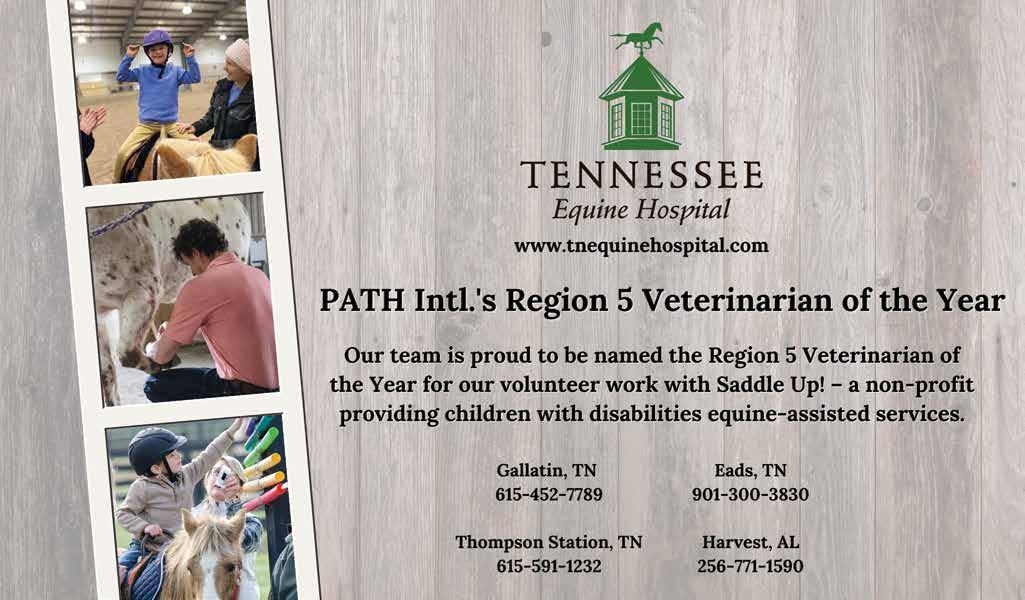
wound care, and pain management. Anytime a puncture wound is suspected your vet should be called right away.
Let’s take a moment to address tetanus - a bacterial infection that carries with it much folklore that most of us have no doubt heard countless times. Tetanus is caused by a bacterium that lives dormant in the soil, animal feces, and even in the intestinal tract of our horses (www.aaep.org). When the bacteria Clostridium tetani enters a wound it can activate and begin to replicate if it is left in an anaerobic state (without oxygen) within the wound. Because of the bacteria’s anaerobic requirements, allowing a fresh wound to bleed initially and then properly cleaning it is the first line of defense against tetanus. If you are concerned that your horse may have been exposed to Clostridium tetani via a wound and is at risk of developing tetanus, contact your vet for treatment options, such as tetanus antitoxin.
Prevention is the most effective measure in protecting the health of your horse. Regularly inspect your horse’s pasture and barn environment for foreign objects and debris that could cause injury. Use a rolling magnetic retriever to pick up metal shards, such as nails. Check fence lines for signs of damage. Keep a first aid kit on hand and check it regularly for expired items and products that need to be restocked. Groom your horse and pick out their feet daily so that injuries are identified promptly. As equestrians we know that injuries are inevitable, but being prepared and responding quickly and appropriately can often lead to a positive outcome.
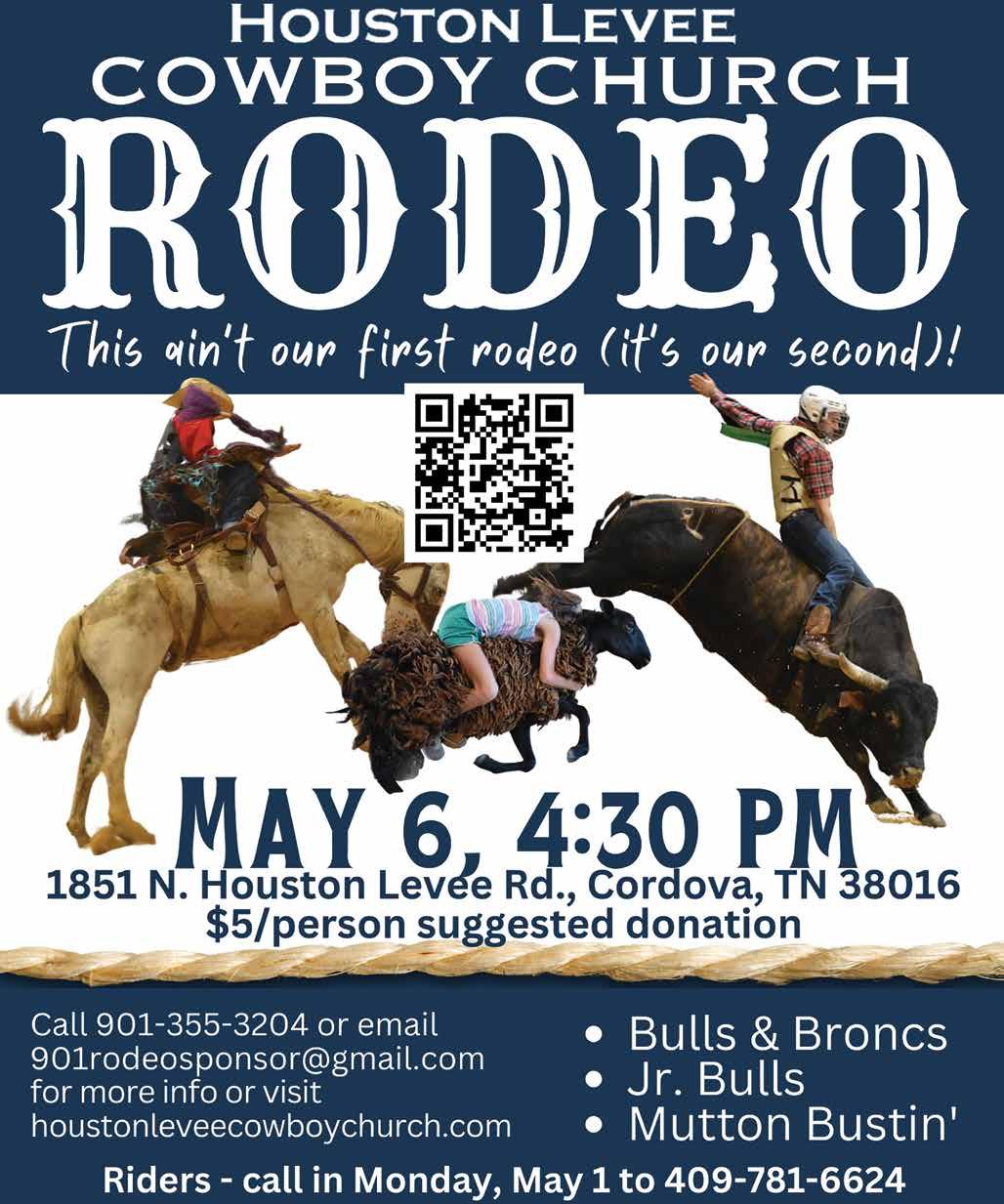

Summer! The season invokes a whole host of emotions for equestrians. We are excited to spend our days outdoors alongside our four-legged buddies, but along with the warmer days comes the frustrations that the heat and humidity can bring. A mid-south summer ushers in the potential for seasonal allergies from pests and pasture. Respiratory and skin complaints are the most common ailments that can plague our horses.
Recurrent Airway Obstruction (RAO), more commonly known as heaves, is a respiratory disease that is caused by the horse’s environment. Heaves presents with a dry cough, labored breathing, and mucus drainage and can range from mild to severe. Horses with this disease can also develop what is known as a “heave line,” which is a visible line of tension in the abdominal muscles just below the ribcage. The horse’s nostrils may flare as its breathing becomes more labored. Heaves is most often a seasonal ailment that is triggered by environmental allergies, but can be observed year round in horses that are frequently exposed to dust or mold. The allergic reaction causes inflammation and restriction in the horse’s bronchial tubes, which then causes the labored breathing, coughing, and mucus buildup.
A vet can diagnose heaves with a simple examination and offer a customized treatment plan. If you suspect your horse may have heaves, please work with your local vet to diagnose and treat them. Pasture allergies are somewhat common in the mid-south region, so an assessment of your horse’s pasture and identifying the plants they have access to can be very helpful. Check their hay, feed, and stalling environment for dust and mold.
 By Michele Harn, M.S.
By Michele Harn, M.S.
With summer comes bugs and lots of them! Irritation from biting and burrowing insects can cause a myriad of skin issues. One of these is Seasonal Equine Dermatitis, which most commonly presents with hives, smaller raised welts that appear suddenly on the skin, and Sweet Itch, a condition characterized by incessant itching. Both Sweet Itch and hives are triggered by biting insects called “Culicoides” (mostly midges and gnats), whose saliva contains an irritant that can cause a hypersensitive reaction in some horses. Sweet Itch is accompanied by chronic itchiness, commonly seen on the belly, mane, tail, ears, and face. Constant scratching of the affected area can further compound the problem by causing sores and callouses.
Hives are a sudden reaction that causes raised bumps on the skin that can appear anywhere on the horse’s body. It is important to rule out other allergies when hives are noticed, as they can be triggered by many allergens, including food.
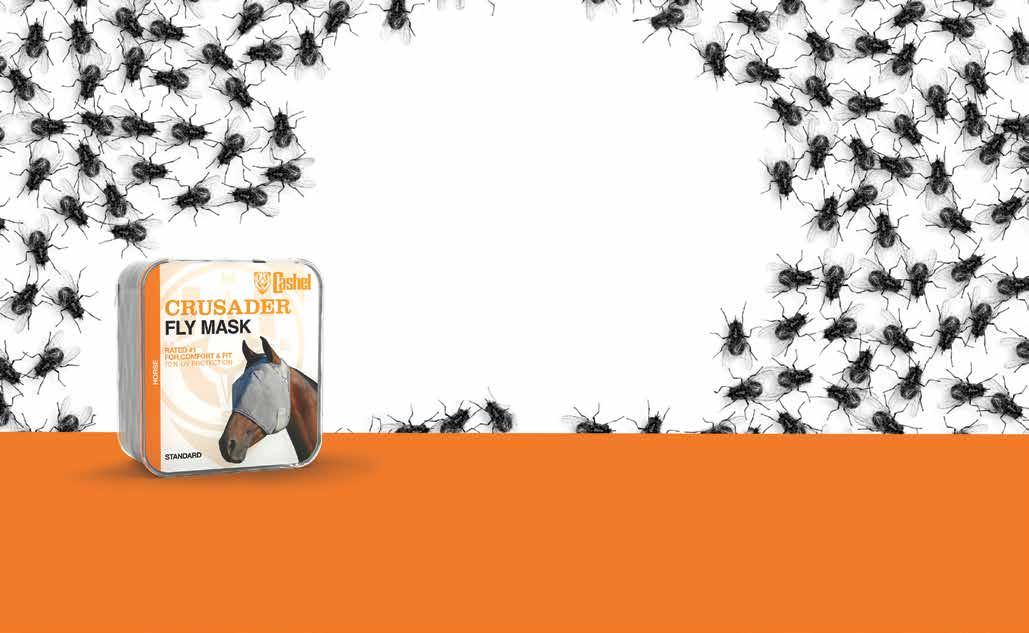
Prevention is the best measure for addressing these skin ailments. Dress sensitive horses in appropriate protective gear such as fly sheets, masks, and boots. Provide an escape from the bugs with proper shelter. Fans and insect screens can deter some pests, as well as the use of topical sprays. Keep manure picked up and eliminate any stagnant water sources, which can act as breeding grounds for some insects. If you notice these skin conditions in your horses and are not able to manage them with prevention practices, a call to your vet can provide more custom treatment and prevention options.
Summer can be an enriching and fun time for equestrians and their equine counterparts. Properly preparing for the
summer season by assessing your horse’s environment can make all the difference. Look for common allergens in their environment that can be eliminated before they impact your horse’s health. Practice good barn hygiene by managing dust levels and providing proper ventilation. Discourage insect populations by removing their breeding grounds. Most importantly, familiarize yourself with what your horse looks, sounds, and acts like when they are healthy so that you can quickly identify when something is off with your beloved friend. We all want our horses to look and feel their best, and planning ahead for the unique challenges that each season presents will set you up for success!
Horses and ponies diagnosed with pituitary pars intermedia dysfunction and metabolic syndrome are prone to laminitis, a debilitating disease that can cause great physical pain and potentially loss of long-term soundness. Nutritional countermeasures may, however, keep susceptible horses from developing laminitis.
“Dietary management often focuses on restricting intake of nonstructural carbohydrates (NSC), namely sugars, starches, and fructans,” said Kathleen Crandell, Ph.D., a nutritionist with Kentucky Equine Research. “The consumption of these particular carbohydrates can increase the risk of laminitis through hyperinsulinemia or hindgut disturbances in laminitis-prone horses.”
Each horse or pony must be nourished in a way that best supplies its nutrient requirements while staving off laminitis. Here are some general points of consideration.

• Diets should be based on appropriate forage, such as grass hay (or hay substitute) with alow NSC content (less than 10-12% dry matter) fed at a rate of approximately 1.5-2% bodyweight. Mature hay typically has lower digestible energy and NSC content when compared to less mature grass hay and legumes, such as alfalfa and clover. NSC content also depends on environmental factors during growth and harvesting. Whenever possible, a forage analysis should be performed on hay intended for horses with PPID and EMS. Soaking hay for 30-60 minutes before feeding is thought to leach sugars and fructans, and may be prudent in the absence of a forage analysis.
• Restrict or avoid access to pasture. The NSC content of some forages can escalate to 40% dry matter at certain times of the year. Consumption of pasture can be
Sponsored Content by Kentucky Equine Research


soaked beet pulp or hay cubes with or without added vegetable oil can provide calories to horses at risk for laminitis.
• Supplement with a rich source of omega-3 fatty acids, such as EO-3. In humans, omega-3 fatty acid supplementation is a therapeutic strategy used for metabolic dysfunction because it improves insulin sensitivity and reduces inflammation. A study in horses indicates that DHA alters circulating fatty acids, modulates metabolic parameters, and may reduce inflammation in horses with metabolic syndrome. *
• Monitor body weight through regular weighing or body condition scoring. Attention to changes in weight or body condition score can keep horses in an acceptable weight range.
* Elzinga, S.E., A. Betancourt, J.C. Stewart, M.H. Altman, V.D. Barker, M. Muholland, S. Bailey, and K. Brennan. 2019. Effects of docosahexaenoic acid-rich microalgae supplementation on metabolic and inflammatory parameters in horses with equine metabolic syndrome. Journal of Equine Veterinary Science 83:102811.
controlled through the regular use of a well-fitted grazing muzzle; strip-grazing behind other horses or sheep; or mowing the pasture short and removing the clippings. Other grazing considerations include choosing a time of day when NSC are lowest in plants (late at night through early morning), avoiding spring or autumn grazing (before flower development or seeding), and steering clear of stressed grasses, such as those subjected to frost or drought. In situations that call for severe restriction of NSC intake, no grazing should be allowed, though an appropriate forage alternative can be fed in a drylot.
• Feed a low-calorie balancer pellet or an appropriate vitamin and mineral supplement to horses and ponies on an all-forage diet. A balancer pellet usually contains a source of high-quality protein such as soybean meal. For aged horses or those with signs of muscle-wasting, a balancer pellet might be more appropriate than a vitamin and mineral supplement.
• Avoid feedstuffs high in NSC, such as straight cereal grains (plain oats, for example) or sweet feeds. Sweet feeds that contain primarily cereal grains and molasses can boost the NSC content to 4550%.
• For lean horses or horses in work, other feedstuffs may be necessary for maintenance of weight. Concentrates low in starch and sugar content (15-25% NSC) when compared to traditional concentrates (30-50% NSC) may be appropriate in some instances. Energy is usually conferred by fat (vegetable oil, stabilized rice bran) and fermentable fiber (beet pulp, soy hulls) sources in these low-starch feeds. In other situations, unmolassed,
A nutritionist or veterinarian may suggest other management strategies based on the individual horse or pony and its risk factors for laminitis. Because there are many causes of laminitis, the disease is not completely preventable, regardless of vigilance.
Kentucky Equine Research is an international equine nutrition, research, and consultation company serving horse owners and the feed industry. The company advances the industry’s knowledge of equine nutrition and exercise physiology, applies that knowledge to produce healthier, more athletic horses, and supports the nutritional care of all horses throughout their lives. Learn more at ker. com.
flects on his overall performance, dedication and talent with horses; “Jayven is my most advanced level youth rider currently. He is always the first to help, and he will ride anything. He never veers away from a challenge. He is stoic, quiet, calm, and disciplined, but he turns into a fierce competitor when he is on a horse. He has a sixth sense and a feel for every horse he rides. This allows him to ride the tough, hot horses that others find difficult.”
Jayven Kilgore started riding at the age of nine. Now, as a 15 year-old, 10th grader and working student at Meadowthorpe Farm, he is focused on extending his education and knowledge with horses as much as he possibly can. His goal is to have a career with horses as a horse trainer.


Jayven is a minority in the world of equestrian sports. Currently 22.9% of all equestrian athletes in the United States are male. And according to the USEF’s US Equestrian 2021 Diversity Scorecard report, 3.27% of equestrian athletes are People of Color. This is a number the USEF’s Diversity, Equity and Inclusion committee is working hard to change. Even though Jayven does not fit the stereotypical look of an equestrian, the real difference people notice about him is his calm and quiet mannerisms while working with horses, especially difficult ones.

Jayven remembers one of the older horses he rode when he was younger. “Gus” was a retired Barrel Racing horse and he was known to be extremely grumpy.

“Gus was mean when grooming and tacking up, but when I rode him he was great. After riding him he was always in a much better mood. He would recognize me whenever I visited him and he would put his ears up when I was around- even though he was grumpy a lot. He liked to work for me and we became good friends. Gus taught me that
I like working with different types of horses that may be difficult for other people. I want to work with those types of horses. The one’s others may not want to work with because they are more difficult and need more patience. It is a goal to continue riding and learning so I can keep improving my skills and work with horses like Gus, and to help those difficult horses learn how to become happier horses who enjoy being around people and working,” Jayven states.
In 2021 Jayven was selected for the Metropolitan Equestrian Team’s Equine Opportunity Program. The MET Equine Opportunity Program allows riders from across the country to become creative with their involvement in equine educational programs that will help them work towards their goals no matter their riding level or location in the country. Riders who are selected for the EOP program have the drive and ambition to make their dreams a reality.
During the summer of 2022 he completed an equine college course through Clarkson University with the scholarship he received from the Metropolitan Equestrian Opportunity Program. He has also completed the Level 2 Certification Course program sponsored by Global Equestrian. Jayven is dedicated to his educational course work as much as his time in the saddle.
Ashlee Pigford, Jayven’s riding coach, re-

Currently Jayven is focused on gaining more horse show experience at mid-south area schooling shows. He has respectfully earned Champion and Reserve Champion the last couple of show seasons. In 2023 he is focused on competing at Hunter/ Jumper and Dressage schooling shows. Jayven said, “Coach Ashlee has taught me tons about caring for horses, understanding how they think, and how to stay calm and focused at shows, and on jump courses. I used to get nervous and have a hard time remembering courses. Coach Ashlee has really helped me with that, and I want to keep jumping more courses and be able to compete at more shows.”
Outside of the barn Jayven’s mom, Jennifer Kilgore, says he enjoys reading and outdoor activities such as camping, hiking and swimming. He is active with the Advent Presbyterian Church youth group and goes on retreats and trips with them every year.
As a ninth grader, Jayven volunteered for Christian and McKrell Baier’s Bridge Up Giddy Up program.
Jayven is currently training with a 17.3h Warmblood Appaloosa named Wiley. Wiley has competed in Dressage, Eventing and Jumping competitions. Together, the pair is focused on developing a close relationship, learning and riding more Dressage tests, and advancing in jumping. Keep your eyes out for this pair during the 2023 show season.

Pilot and author, Mark Bernegger, is no stranger to the business world. Having found ed and grown an outdoor products company for over twenty years, it is not surprising he promptly started up another business, LifeSigns, after deciding to sell his original business.
Officially opened as of early fall 2022, LifeSigns was created when Mark and fellow pilot, Walt, who is passionate about airplanes, noticed an intriguing sign hanging on the wall as a decoration in the aviation-themed restaurant they were dining in. Knowing Mark dabbled in metal projects, Walt asked if Mark thought he could make him a similar, airplane-themed sign in a metal version, and Mark told him he could.
The creation of that first themed sign for Walt led to another co-worker requesting one that aligned with his passion, golf. From there, the light bulb went off for Mark. “I know people who are [passionate] about horses, turkey hunting, fishing, etc., and it snowballed from there into 16 designs with more in development,” says Mark.
“LifeSigns are beautiful, handcrafted pieces of artwork that showcase what you are passionate about,” says Mark. He can, literally, take “Your Life, Your Passion” and create a beautiful decoration that breaks down whatever you are enthusiastic about into words de-


Mid-South equestrians take pride in their love for the horse world. What better way to show your passion for all things horsey? For all the cowboys and cowgirls out there, Mark has a rodeo-themed version.
Mark has presented his appropriately themed LifeSigns to Ducks Unlimited, Rocky Mountain Elk Foundation, National Wild Turkey Federation, and Tunnels to Towers for consideration for use in their organizations.

scribing that particular lifestyle: faith, sports, the beach, horses, careers, etc. LifeSigns are eye-catching ways to let friends, family, and clients see what is important to you. These 12”w x 38”h signs make gorgeous additions to any home, office, or barn. “The hammered copper finish and black lettering with special graphics make them true conversation pieces,” Mark states. LifeSigns are not simply decorations; they are truly unique pieces of art.
LifeSigns are made in two parts, Mark explains. The front is 16 gauge metal and the letters are plasma, or laser cut. That piece is then painted front and back with a hammered copper paint. The back is a combination of aluminum and acrylic composite. The two halves are then aligned and holes are drilled for the hardware. They are then bolted together with decorative bolts, washers, and nuts. The final step is to add a wire for hanging on the back and finishing it off with a merchandising label and contact information. Each unit is assembled by hand in West Point, Mississippi, and all the items used in manufacturing are sourced from either Miss. or Tenn.
Although not a horse owner himself (Mark jokes he is the proud owner of a “Minnesota Quarter Horse”), his sister, who is a horse owner, inspired him to create an equestrian-themed LifeSign. It is no secret many

When asked what he hopes for as far as the future of LifeSigns goes, Mark explains the next stage of LifeSigns will be Welcome Signs, a smaller version of the original LifeSign. These Welcome Signs will be perfect for hanging near the door. Still made from beautiful, hammered copper finish with black trim, the smaller Welcome Signs do not have the terminology associated with the theme as their larger LifeSigns counterparts do.
Currently Mark is producing 16-17 variations of his LifeSigns, but plans to expand the line in the future to include holidays and other themes. To see his work in person, stop by his vendor booth at the Germantown Charity Horse Show, June 6-10, 2023. He also plans on having a booth set up at Celebration Village in Tupelo, Miss., October 18-21, 2023.
LifeSigns is completely run by Mark. On his website (https://lifesignslife.com) there are examples of work from all kinds of passions and hobbies. Mark can take orders over the phone or email: (662) 295-5702 or email Mark at LifeSignLife@gmail.com.




enough to have the tools and talent to build their own fences, most will need to hire a professional to get the job done. As with all professional services, ask around, get references, and a detailed estimate before hiring someone.
Zach Burrows of Local Fence in Rossville, Tenn., grew
replace fencing.
Four Safest Horse Fence Materials: 2”x4” woven wire (not welded), coated high tensile rails (e.g. Centaur Fence), four-rail fence (wood or vinyl), Electrobraid (heavy woven electric rope). Many fencing options will have better longevity if a board is added at the top or if an electric strand is added to keep horses from leaning on the top. Sometimes an electric wire mid-height can keep little ponies from rubbing on the fencing.

Fencing Mistakes: not using proper materials; sacrificing safety for cost (keep project within budget without sacrificing integrity and safety of the fence); not considering traffic patterns and potential mud areas; not keeping fence line clear of weeds, trees, and vines; buying cheap materials; hiring inexperienced installers.
Safety Concerns For Horse Fencing: sharp corners, sharp objects/materials (use T-post caps, be sure any wires are tied off), improper gate, weak/cheap gate hardware, poorly mounted gate, guide wires from power poles should not be within pasture (or fence them off from horse access), avoid tight areas (corners less than 90 degrees), never use barbed wire, regularly inspect fence for safety and strength.

up in the business learning from his father, Steve Burrows, another local fencing specialist. After college and a short ing full time. He has an easy demeanor and readily shares his knowledge while eagerly seeking input from clients. A master in his craft, he builds fences to USDA standards on all jobs, whether for horses or other livestock. Following are his essential notes for horse owners looking to add or
Fencing is an investment and not a place to skimp on quality of materials or construction. While prices and aesthetics can vary widely by style, material, and contractor, a durable fence keeps your horse safely at home, adds value to your farm, and is a thing of beauty in the eye of a horse owner. Find the fence that fits your budget and enjoy the view!
Here in the Mid-South, we’re currently in the transitional months between winter and summer that are known for being soggy. In the equestrian world, these rainy months are notorious for creating mud in pastures, paddocks, and around the barn. For many horse owners and riders, spring mud can create messes and safety hazards as well. Fortunately, there are some things you can do to help manage and minimize mud this spring.

First, avoid overcrowding. Too many hooves stomping and churning up the ground kills the grass; these grassless, dirt areas are then easily turned to mud during the next rainfall. Also, remove manure from your pasture or paddock every few days, if possible. Spring rain plus manure can quickly turn turnout areas into muddy nightmares. Since one horse can create around 50 pounds of manure daily, it is necessary to pick small pastures, paddocks, and turnout areas routinely for mud management.
If you notice certain areas around the barn staying consistently muddy this spring, consider installing gutters to control water runoff. If you already have a runoff system, ensure your gutters are free of leaves and other debris. Redirect the rainwater from the foundation of the barn or shed and prevent it from flowing into high-traffic areas. Consider redirecting into rain barrels or other portable water containers to store and use the rainwater for later use, such as watering spring gardens or flower beds.
High traffic areas at gates, barn entrances, or around water troughs and salt/mineral blocks are likely to become slippery, muddy messes this spring. Providing dry footing is a way to combat this mud. Geotextile pads are available on the market to place in areas where it’s impossible to deter congregating equines or decrease foot traffic. These flexible, grid-like pads provide dry footing during the soggiest
By Alicia Johnsonof weather. However, if these pads don’t fit your current budget, consider laying down sand, gravel, or some other suitable substance that will create safe footing for both you and your horse while also allowing water to drain.

Creating a buffer by fencing off the area in between your pasture and an area at risk for holding water is another way to fight against mud this spring. Planting something in these buffer areas is a great, organic way to stabilize the soil and create a means of absorption, thus minimizing mud.
Not only is mud a safety hazard for both the equine and equestrian, but it also becomes a breeding ground for parasites, which can cause painful hoof abscess and other equine hoof ailments. Horses exposed to excess mud this spring
should have their hooves cleaned and inspected regularly for cracks and openings that can easily allow fungi and bacteria that cause thrush and other unwanted hoof problems to enter the hoof. Check with your veterinarian first, but you may want to consider a hoof-health spray or paint-on solution as a means to be proactive if you find it hard to keep your horse out of the mud this spring.
It is important to note that spring is a good time to check your fences. Wet, muddy ground can create shifts in your fence posts, and, therefore, decrease the integrity of your fence. Also, don’t plan on fertilizing as long as there’s spring mud. Muddy areas can cause fertilizer runoff into local water sources.
Dry weather, rain and mud, and humidity, combined with stomping to deter flies can take a toll on your horse’s hooves this summer. Here in the Mid-South, most equestrians are gearing up for spring and summer shows, events, and trail rides, but we need well-maintained hooves in order to compete and show. “No hooves, no horse,” right?
Since hooves tend to grow faster in the summer, keep your horse on a regular schedule with the farrier. Regular trimming and shoeing will ensure your horse
Brittle hoof walls, dried out by environmental factors, can chip, crack, and crumble, and rapid changes in moisture can further break down the integrity of the hoof.

To combat this, consider using a hoof conditioner. A conditioner containing a phospholipid is especially beneficial. Phospholipids, also found in human skin, can help maintain the moisture balance in your horse’s hooves no matter what this Mid-South summer throws at us: severe heat, thunderstorms, or drought conditions. Omega 3 fatty acids, found in grass and linseed meal (if your horse has restricted access to fresh grass) are also beneficial in providing healthy levels of phospholipids.
As always, contact your veterinarian or equine nutritionist before making any changes to your horse’s feeding regimen. Supplements or mineral blocks containing biotin, zinc, and copper, and a good supply of essential amino acids, like methionine and lysine, can all encourage strong, healthy hooves in your equine.
is comfortable and its hooves are in good condition. As a general rule of thumb, most horses do well on a four to six week trimming schedule throughout the summer; however, this will depend on your horse, the terrain it lives on, and your discipline of riding. Show horses may need to see the farrier at shorter intervals.

Like everything else that dries out in hot weather, horses’ hooves do too. Just like human hair and nails, horses’ hooves are made of keratin, a living tissue, and will be affected by the drying heat this summer.
David Gitchell, longtime horseman and local farrier, has been around long enough to have heard the old-time cowboy rule of watering down around the water trough or purposely overflowing it in order to create a little mud, and thus, moisture, for your horse’s hooves in the warmer months. In fact, a quick internet search reveals ground water horses can periodically stand in is actually encouraged for the hoof moisture needed in dry conditions.
Another way to promote strong, healthy hooves this summer is to feed a balanced diet and a feed-through hoof supplement.
If your horse is prone to fungal or bacterial hoof ailments, such as thrush or white line disease, you may not want to use any hoof hardening dressings this summer, as these types of dressings can actually make the hooves more susceptible to cracking and chipping. Active ingredients to avoid in a hoof with a known fungal or bacterial problem include formaldehyde, copper sulfate, acetone, and turpentine.
If you have the option of keeping your horse stalled at night, this can combat the wet-dry-wet cycle the thick, summer dew creates, causing those negative moisture changes in your horse’s hooves. If you do choose to stable at night (or even for a portion of the day), consider the bedding you use in the stall. Absorbent bedding, such as a pelletized version, will contain the moisture and prevent your horse from further moisture changes while stalled.
Proper warm up and cool down in your horse’s exercise routine promotes both strength and flexibility for your horse just like in humans. Increases in agility, protection of the horse’s muscles, and increased comfort are all benefits of taking the time to warm up your horse and cool it down. As we move into the warmer months, there are some precautions to take when warming up and cooling down in the Mid-South this summer.
When it’s hot this summer, a warm up can start with grooming. Not just for cleaning, a thorough grooming can double as a massage and get your horse’s muscle fibers prepared for movement. Use a curry comb or even a massage tool to prepare your horse for riding. Working against the grain of your horse’s muscles can increase circulation and warm up its muscle fibers. Another added bonus of beginning a warm up with grooming is the bonding it promotes between you and your horse.
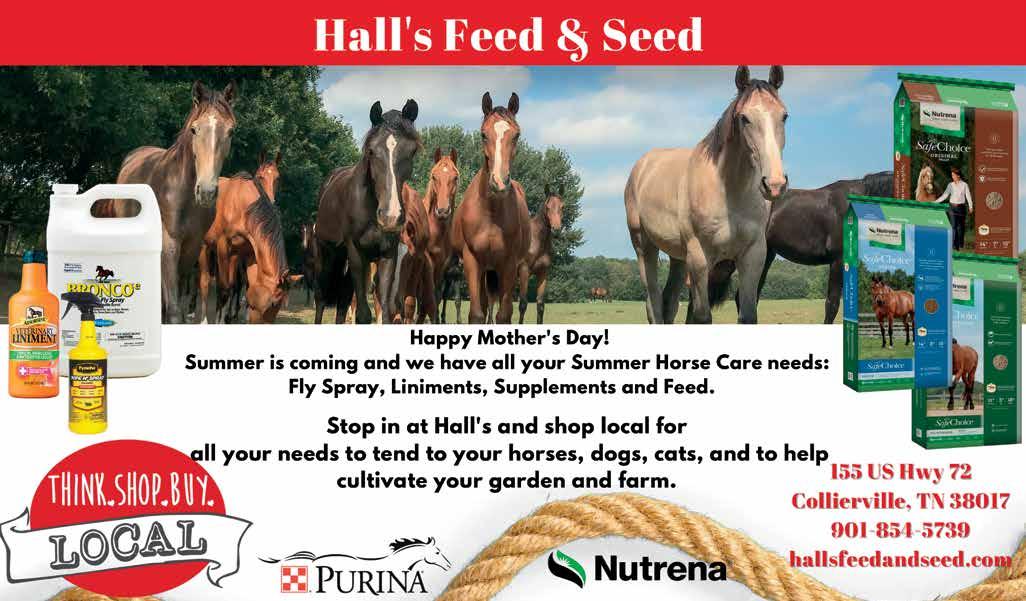
Once groomed, continue your hot weather warm up by adding movement. On a humid Mid-South day, consider 10-15 minutes of hand walking instead of lunging. If you do choose to lunge as part of your warm up, perhaps you let your horse walk
By Alicia Johnsonmore and trot and canter less. Walking will still elevate your horse’s heart rate, stretch its muscles, and increase blood flow as you prepare to ride.
The cool down is equally as import ant after a ride on a hot day. Touch your horse’s chest, shoulders, and legs. You want its chest and shoulders to feel like the same temperature by touch. This can be achieved by walking your horse down. Just like the warm-up, on a hot day, consid er walking your horse by hand, instead of under saddle, as a cool down. Untacking before you hand walk your horse will also help it to cool down more quickly. Once its chest and shoulders feel like a similar tem perature, feel its legs; if you can still feel the warmth radiating from them consider wrapping up your cool down in the wash rack with the hose and cold water. Remove any excess water with a sweat scraper.
Michele Burgess, former co-owner of Burgess Equestrian Services, suggests riding either early in the morning or later in the evening in order to avoid the hottest parts of the day this summer. As far as cooling down in the heat goes, she suggests cold hosing your horse. Once you’ve walked your horse down and its respiration
rate has returned to normal, spraying the equine down with cold water is a good way to cool it off, literally. Michele advises you to start hosing on the horse’s legs and gradually work up to avoid giving it “a jolt of cold.” Cold hosing will draw the heat away from your horse’s legs and reduce the
chance of any swelling after a ride on a hot day. If you plan to stall your horse after it has been hosed down, she also suggests keeping a fan on it in the barn to dry.

Flies are, perhaps, one of the least fun aspects of being a horse owner, caregiver, or rider this time of year. Here in the MidSouth, equestrians battle flies for the majority of the year. How can we ever come out on top of this struggle?

First, consider combating flies from the inside out. There are numerous supplements and fortified mineral blocks on the market promoting feed-through fly control. An organic, DIY option is top-dressing
Sprinkling garlic powder on the horse’s food is another way to repel flies naturally. Among numerous other health benefits, the odor garlic produces as it is excreted through the skin (in sweat) discourages biting flies. 1 tsp. top-dressed onto feed should be all you need to help keep flies away without the taste and smell overwhelming your horse. As always, consult with your veterinarian before supplementing or making any changes to your equine’s feeding routine. Feeding too much garlic could have potential adverse effects.
bumps for the next 24 hours; if no reaction is noted, you’re good to spray away.
your horse’s feed with apple cider vinegar (ACV). Depending on the horse’s weight, try feeding ¼-½ cup of ACV daily. Dilute the vinegar with water, 50/50 and add to your horse’s usual feed. You can also drizzle ACV over the hay ration. Daily ingestion of ACV increases the level of thiamine (vitamin B1) excreted through the horse’s skin. In turn, this discourages all types of biting insects, including flies and mosquitoes.

Numerous fly sprays and spot treatments are available at any local feed store, but have you ever considered making your own fly prevention spray at home? This is also a more economical, organic DIY option. A quick internet search will leave you with numerous recipes to choose from. Many of these contain ACV and essential oils. One recipe is as simple as combining 2 c. white vinegar, 1 tBsp. eucalyptus essential oil, and 1 c. water. Take the following precautions if you do choose to use a homemade spray: let your horse smell the bottle before spraying (some horses may not like certain essential oils) and test for an allergic reaction. Spray a small amount on an area where you can observe any hives or
Mesh fly sheets and fly boots provide a physical barrier to keep flies off your equines. Although these options may be easy solutions for equestrians who aren’t able to fly spray their horses daily, they can have drawbacks as well. Some horses may become overheated as we creep into the hotter, summer months. Other horses’ skin may become irritated due to the rubbing of the fly sheet across sleek skin. If you do use fly sheets or fly boots this summer, be sure to remove them regularly and assess your horse for any areas of irritation these products may cause. Fly boots on the hind legs should be checked daily, as they can catch manure.
Physical fly removal options, including stick trap ribbons and disposable fly traps (just add water and the odor draws the flies into a bag from which they cannot escape), are available to hang in and around the barn as well. Joanna Wilburn of Rollingwoods
Farm in Olive Branch, Miss., has tried disposable fly traps in the past along with fly predators as well, but finds the struggle against summer flies to be a continual one. She has found stall fans help in the fight to keep the flies off her ponies.
the horse itself. Another option is to go to your local pet store and purchase a dog identification tag with your contact information printed directly on the tag. This tag can then be braided into your horse’s mane or tail.
Other disaster preparedness tips for horse owners and caregivers include keeping extra feed and water on hand if possible. Roads can quickly become impassable after a tornado, so running to the feed store may not be possible for a few days. Portable water containers and emergency water storage tanks are available to keep in the barn in case water lines are damaged.
Keeping your fences well-maintained during storm season is another important way to stay prepared. Limbs kept cut back off the fence line can help ensure the integrity of your fence when the wind starts to blow. Investing in temporary panels is a good idea if you do not already have a round pen. If you were to experience the collapse of a barn or a break in your fence after the storm moves through, temporary panels will allow you to easily set up a short-term stall or area to house your equine.
ly Saturday morning on April 1, 2023 left many horse owners and caregivers reeling. Although forecasted, these storms produced unpredictable winds and tornadoes with little warning. Equine owners throughout the region were left with little time to prepare for these storms.
In severe weather situations, we know the best place for ourselves: inside, on the lowest floor or basement, in an interior room. Many have a storm or disaster plan for ourselves and our family. However, when it comes to our horses, we can make preparations and plans too.
First, when severe weather is forecasted, horse owners and caregivers must decide what is best for their equines: inside or out-
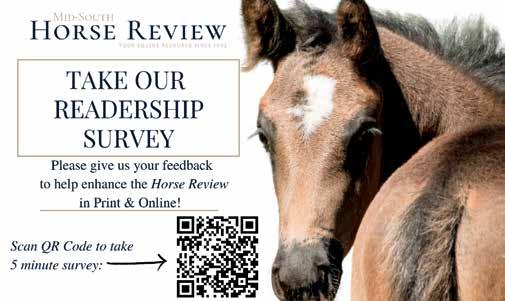
to get out of the storm’s path. Being flight animals, horses instinctively will flee from immediate danger. If tall trees are present in the pasture, they can serve as lightning rods to help decrease the chance of the horse itself being struck. However, turning out in a large pasture can also put the horse at risk; falling trees, flying debris, or damaged fences can all be threats.
If your horse is unaccustomed to being in a large pasture, keeping it stalled may be the best option to decrease its anxiety during the storm. However, keeping horses in a stall during severe storms raises the risk of the horse being injured if the barn becomes damaged. Brick and concrete barns have a better chance at sustaining high winds than
metal structures do. Local barrel racer, Lexi Henderson, says she leaves her horses turned out during storms “because it’s safer in case something were to fall on our barn, like a tree, or if it were to get struck by lightning.”


No matter where you choose to keep your horse during severe weather, consider tagging it with your name and phone number. This can be done in a variety of ways. A breakaway halter with your name and contact information can be put on every horse. If you are concerned about the possibility of the halter becoming caught on something, like a fence post or tree branch, you can use a livestock paint marker to write your phone number directly onto the body of your horse. If your horse were to get out of the barn or pasture, people will be able to read your number directly off your horse, even if they cannot catch
Jonathan Fortenberry, Risk Manager and Insurance Agent for American National, cautions you, from a preventative standpoint, to let your insurance company know the value of your barn, shed, or other buildings or structures on your property, including the fence as well. If your property does sustain damage, Jonathan suggests following these steps. First, file a claim and let your insurance know what structures are damaged. Next (and only if you can do so safely), protect and preserve your property that’s not damaged, and take plenty of pictures and videos of property that is damaged. If your property is unlivable, or a building on your property can no longer produce income you depend on, your homeowner’s policy or farm policy may cover those living expenses. Finally, begin getting estimates, but Jonathan recommends refraining from signing any contracts until you talk to your adjuster.
ter should not exceed 64 degrees. However, for those of us with metal or black, plastic water troughs in the pasture, the sun heats the water quickly. Consider freezing a couple of milk jugs filled with water to place in your trough. These will act like ice cubes and help regulate your horse’s temperature from the inside out.
Another way to ensure your horse is adequately hydrated this summer is to give your horse an electrolyte supplement. Electrolyte paste is a fast-acting way to ward off mild dehydration. Electrolyte powder can be placed in horses’ feed or even dissolved in the water trough. A mineral block or salt lick will also replace vital nutrients and minerals, as well as encourage your horses to drink this summer. As always, consult your veterinarian before giving any supplements.
Normal cooling is almost ineffectual with a heat index of 180 or greater, and therefore, riding is a no go. A heat index greater than 150 also requires exercising caution; watch for signs of heat stress in your equine, and you should still hold off on that ride. 130 and below on the horse heat index indicates your horse can keep itself cool, and you can enjoy a summer ride.
The mild spring temperatures we’ve experienced recently here in the Mid-South will soon give way to summer’s extreme heat. Caring for horses during hot weather brings about a different set of challenges. However, there are some things you can do in and around the barn this summer to ensure your horse is comfortable.
First, provide unlimited access to clean water. Ideally, the temperature of your wa-
As mentioned in the “Warming Up and Cooling Down in Hot Weather” article, be mindful about what time you ride and work your horse this summer. As a general rule, you can determine if it is too hot to ride by adding the actual air temperature to the humidity and get a horse heat index number. For example, on a 95 degree day this summer with a relative humidity of 85%, the horse heat index (temp. + humidity) would be 180 and warrants you to use extreme caution.
Julia Whitehead, local trainer and rider, suggests riding in the early morning or late in the afternoon to beat the heat. “A shady spot to ride is always preferable, so I will often stick to slower paced trail rides in the shade if possible,” she states. If it is extremely hot, Julia may choose to work on groundwork or slower paced work under saddle. On a hot, humid day, she “avoids extensive trotting and loping to keep from overheating the horse.” After a ride, she always hoses the horse down with cold water and puts it under a fan or in a shady spot to dry off.
Turnout time may need to be adjusted as well this summer. If you do turn out in the middle of the day, or if your horses live outside, be sure there is shade in your pasture to provide relief from the scorching heat. White or lighter skinned horses, or those with pink muzzles are prone to
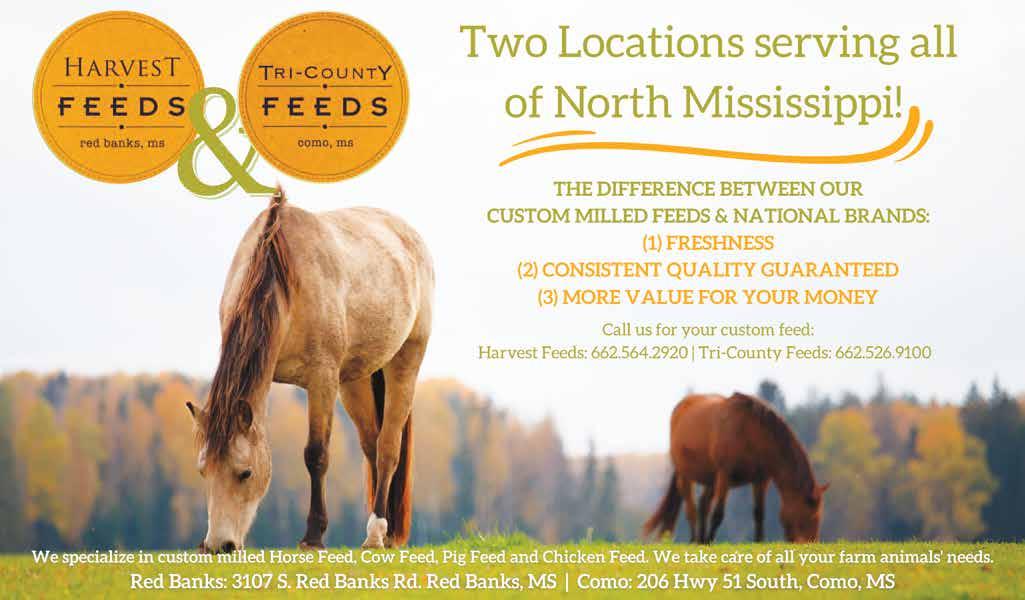
sunburn. Use a full fly mask on your horse as a physical barrier from the sun. If there are still pink or light areas exposed, human sunscreen can be applied to these vulnerable areas. Be sure to ok the use of human sunscreen on your horse with your vet, but, generally, those without para aminobenzoic acid are safe for horses on small areas of the body. There are also specially developed equine sunscreens available on the market. Just like when we use sunscreen ourselves, it will need to be reapplied every couple of hours, according to the directions.
If possible, use fans (misting fans are even better) to keep your horse cool in the stall. Absorbing water through its skin will help keep your equine from sweating, thus further losing fluids and working against dehydration. Open any doors and windows in the barn to allow fresh air in. The hot, humid air will rise and continue to draw in yet more fresh air.
If you need to transport your horse, try to haul during the early AM or late evening as well. Remember to open any trailer vents to maximize air flow and offer water to your equine frequently. Doing your best to keep your horse comfortable this summer should result in a happy equine.

Junior Division (grades 4th-5th)
Abigail White
Junior High Division (grades 6th-8th)
Shianne Galayda
Sophia White
Kaylee Wooten
Senior Division (grades 9th-12th)
Serenity Green
Layla Holland
Eliza Yucalevich
The Horse Judging Contest tests youth’s knowledge on horses in terms of evaluating conformation, form-to-function, unsoundness, blemishes, performance and other factors to distinguish desirable versus undesirable characteristics in horses, riders and equine performance events. Senior level contestants are asked to defend their reasoning and logic while delivering oral reasons sets. Youth judge a variety of horses, from stock-type Western, Walking horses, and Hunter type horses in halter, along with under saddle classes.
Scores are tallied and youth are awarded on individual scores, and 4-H clubs are awarded on a team level. The top four senior teams qualify for the state contest at the 4-H Horse Show in June.
The team went up against 19 other counties in the Western Region and a total of 140 other competitors. The youth had to judge the following classes:
1. Stock type geldings
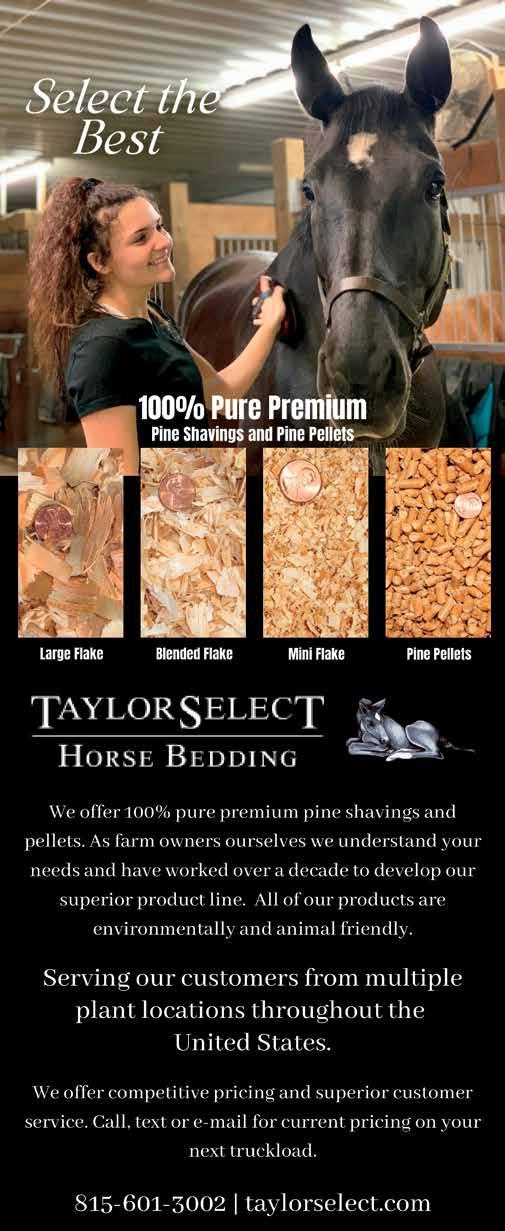
2. Stock type mares
3. Ranch Pleasure riding
4. Hunter Under Saddle
5. Horsemanship
In addition to ranking the four horses in each class, the senior members had to give reasons to defend their placings in two of the classes to the judges.
In the end, the Ghost Riders represented Shelby County 4-H extremely well! The results were: Abigail White finished in the top 15 for the Junior division in the individual competition.

Junior High team finished in the
However, the highlight of the contest was that the Senior team finished Reserve Grand Champion for the region and will test! UT TSU Shelby County Extension are proud of the Woodstock Ghost Rider’s team and cannot wait to see the Senior Team represent the county in June.
The team is thankful to their club leader, Ms. Kim Looney, and their agent, Kyla Szemplinski, for their respective guidance and teaching that helped them prepare for the contest. They are also thankful to Hunter’s Edge Stables and Massar Stables that allowed them to come for in-person sessions, which exposed them to multiple disciplines. To help with horse judging skills, Kyla called trainer, Gene “Beanie” Cone, and fellow riders at Hunter’s Edge Stables to help the Ghost Riders 4-H club with judging hunter type horses. A few weeks later at local dressage barn, Massar Stables, the Ghost Riders were able to judge a class of hunter type horses in conformation and under saddle class with help from trainer, Caitlyn Massey. The team is grateful for all the support equestrian facilities in Shelby County has provided.
The Woodstock’s Ghost Riders are always looking for new members. Individuals do not have to own a horse to participate in 4-H. It is a great way to learn about horses, travel to different parts of the county, meet industry professionals and be exposed to different career paths and future opportunities. Woodstock’s Ghost Riders 4-H Group is open to all ages. For more information about how to join the Woodstock’s Ghost Riders or other Shelby County 4-H clubs, please contact the Shelby County Extension office at 901-752-1207.
Programs on agriculture and natural resources, 4-H youth development, family and consumer sciences, and resource development. University of Tennessee Institute of Agriculture, U.S. Department of Agriculture and county governments cooperating, UT Extension provides equal opportunities in programs and employment.


The best weekend all year has come to conclusion with the first American victor in 15 years at the Land Rover Kentucky Three-Day Event! Tamie Smith went double-clear in the Show Jumping on Mai Baum to clinch the win on her dressage score of 24.2. Second place, from start to finish, was British rider Tom McEwen on JL Dublin, also going clear in the Show Jumping to finish on 27.8. Third place went to Liz Halliday-Sharp on Miks Master C, having a third clear Show Jumping ride, and ending on a 28.5. With Land Rover Kentucky under her belt, Tamie’s now got her sights set on Paris 2024.



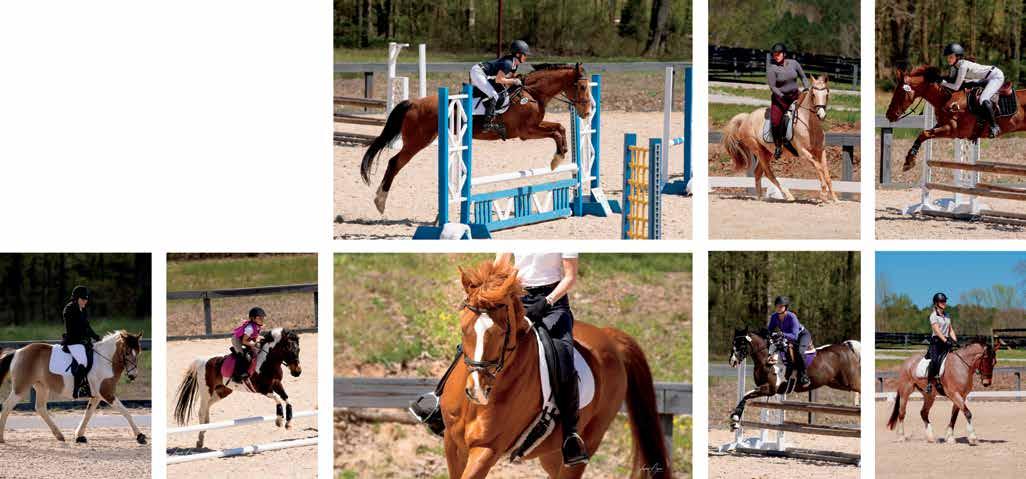

 Photos By Laura Ayres Photography
Photos By Laura Ayres Photography
North Grove Equestrian Park, located in Oxford, Miss., hosted the first 2023 Memphis Eventing CT Schooling Show on April, 1. The ME CT Schooling Show Series started in 2022 and plans to have six shows this year throughout the Mid-South Region. The next planned CT Schooling Show will be held at New Prospect Farm in Columbus, Miss., on May 20. Photos were taken by Laura Ayres Photography. To see more photos from April’s CT Show visit Laura Ayres’ Facebook page: https://www.facebook.com/lauraayresphotography.
 Photos By Gary Cox
Photos By Gary Cox
The Volunteer Ranch Horse Association (VolRHA) recently held its April Eggstravaganza at the Agricenter ShowPlace Arena in Memphis, TN.
A 3-day VolRHA show was held April 14-16, 2023, at the Agricenter in Memphis. This April Eggstravaganza was the first 3 day show (in the past it has been just 2 days). All 3 days were packed with activities including NRCHA, AQHA, VRH, AQHA Ranching Heritage, AQHA, APHA and VolRHA club classes with over 200 classes offered.
Remaining shows for 2023 are May 19-21, September 22-24, and November 3-5 at the Agricenter in Memphis.
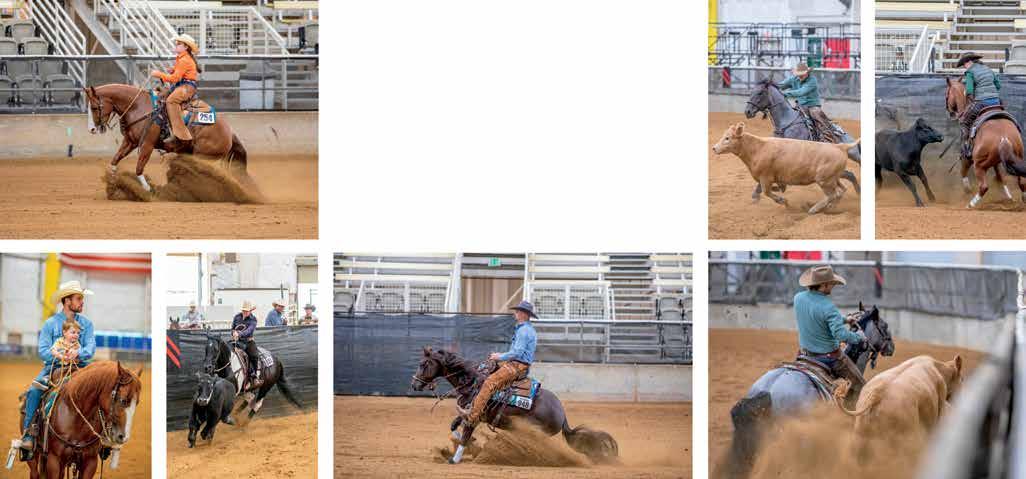

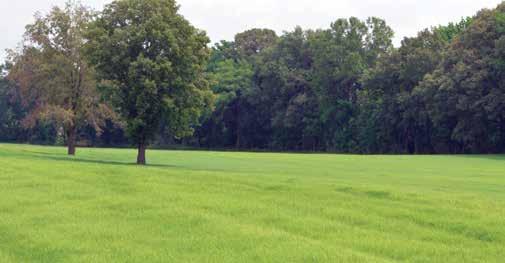

Photos By Gary Cox
JLJ Productions Barrel Race held their April Race Series #3 on April 25, in Jonesboro, Ark., at the ASU Equine Center. JLJ was founded by Jessica Lauren and Julie Webbe, two Northeast Arkansas Barrel Racers with a goal of hosting fun, local, wellran events.
JLJ Production has support from the Jonesboro community which sponsors the series. Without the support of sponosrs the series would not be possible. To see more photos from the series visit Gary Cox’s website: https://www.gcphotoproductions.com/Horse-Shows-2023/4-25-23-JLJ-Spring-SeriesJonesboro-AR


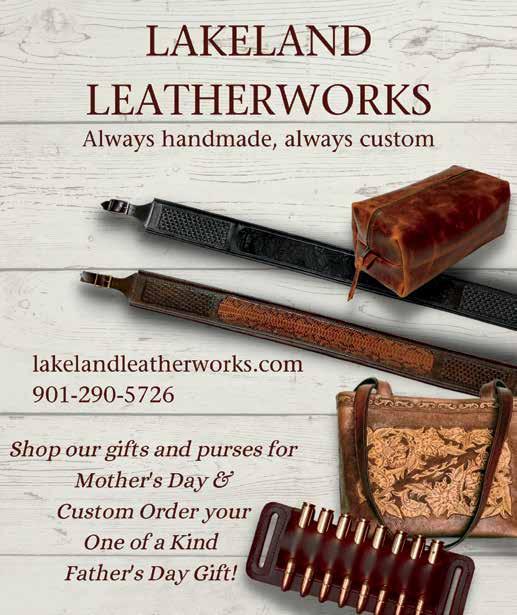
Sunday Funday is a series of family fun bull riding events put on by BuckWild Bucking Stock in Como Miss. The first event of the year was their second annual Bulls and Bugs event held Sunday, April 23. The Bugs refer to over 300 pounds of crawfish that are cooked and served on location by Big Erns Crawfish along with the riding of bulls. With over 30 bull riders coming from throughout the mid-south, the fast paced bull riding was continuous, starting with the junior riders (16 and under) where Harris Brown and Collin Robert’s tied with a score of 62 on their qualifying rides. Mr. Luke Stanley, who also rides for the Northwest Mississippi Community College Rodeo team, in Senatobia Ms, won the open event with a high score of 79 points. Five more Sunday Fundays are planned for the next five months on either the 3rd or 4th Sunday of the month, more information can be found on Facebook or check out Buckwildbuckingstock.com for the dates.

Hillside Stables – Desoto Co – Bill and PK Theobald have been professionally caring for horses for 23+ years. Spend time with your horse while full board covers all the daily chores. Horses fed 2x daily, stalls cleaned daily, same sex turn out. $450 per month. Happy, healthy horses – friendly, knowledgeable people. Covered arena, round pen, lighted outdoor riding area and wooded trails! Check us out on Facebook, website: www.HillsideStables.wordpress.com or call 901/857-7500.
Premier Horse Boarding in Fayette county. Full/pasture board. Retired horses are welcome. Private pastures, grained 2x daily w/senior feed & Bermuda hay. All weather outdoor arena w/lights. 50+acres of riding, lots of additional amenities. Look us up on FB. Blues City Warmbloods Dana 901-331-3500
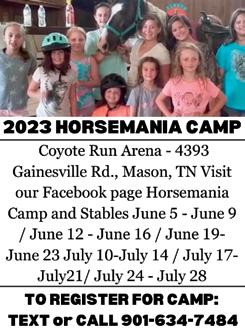
HORSE TRAINING
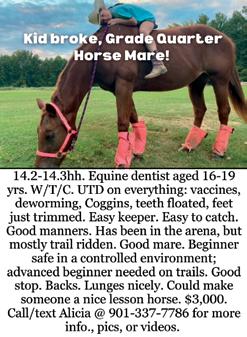
Training your horse, the correct & gentle way. Desensitizing & teaching respect on the ground; trust without fear. We mostly use the Buck Brannaman training methods. Exc. References. Grained 2 x day w/ Bermuda hay & private pastures. $800 Mo. Michael Garner 901-857-8060 Blues City Warmbloods on FB
Boarding at beautiful WHITE OAK FARM: Located on 40 acres in northeast Shelby County at 10023 Rosemark Rd. Full Board $400/month. Board includes stall cleaning/shavings and morning/evening feedings.
Numerous amenities include large stalls with windows, stall fans, heated waterers, turnout pastures, lighted outdoor arena or inside barn riding, crosstie area with hot/ cold wash rack, fly spray system, Bermuda hay grown and baled onsite. Gated facility with owners and farm manager living on property. Call Sammy 901833-3075.
Nice friendly barn located in Cordova/ Memphis, TN. Located 15 minutes from Germantown, Bartlett, East Memphis and Shelby Farms.
Owners are on site. Retired or Aged horse’s welcome! High dry barn, trails, and small arena. Call Rob (901) 359-3341

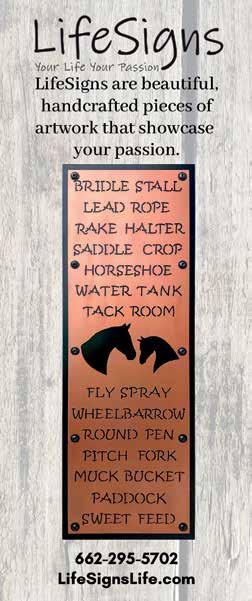

Lakeland 14 stall barn for rent. Wash rack, feed/tack room and hay storage. $1,500/month for the entire barn or $125/month per stall (3 stall minimum). Non public use only.
Nice barn apartment for rent: $700 a month. 901 338 9686.
Lakeland 3 acre pasture with 3 stall barn for rent. 2 horses maximum. $250/month. 901 338 9696
White Oak Farm: Full Time job opening for a hard working individual with experience around horses.
Job duties include cleaning stalls, feeding horses, bedding stalls, cutting grass, weed eating, operating farm equipment, stacking hay and everything involved with caring for 25 + horses and 40 acres.
SADDLE REPAIR
SADDLE & TACK REPAIR:
Van’s Leather Craft. Custom gun holsters, belts, knife sheaths, photo albums etc. For sale: Used & new saddles and horse health products.
Off Hwy. 309, 1909 Bubba Taylor Rd., Byhalia, MS. (662) 838-6269.
You will be responsible for feeding horses on alternate Sundays. Call 901-833-3075 or 901-458-4314 for details. whiteoakf@ aol.com 10023 Rosemark Rd. Atoka, TN
Horse-drawn carriage drivers needed in Downtown Memphis. We will train. No experience necessary. (901) 496-2128. uptowncarriages.com


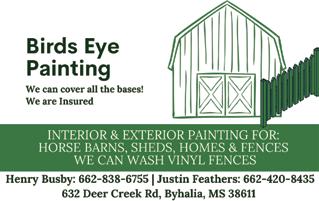



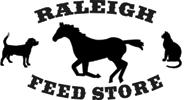







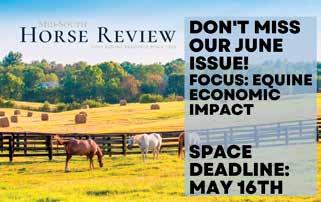
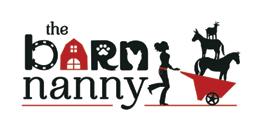
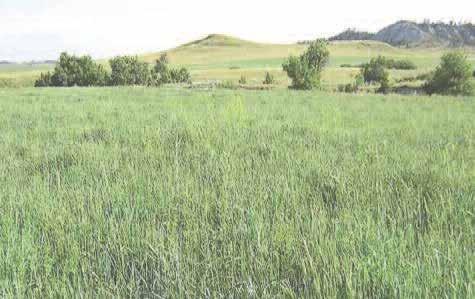
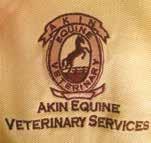






http://www.agricenter.org/events/
MAY 4-7: Lucky Dog Barrel Race
MAY 19-21: VolRHA. www.volrha.com
Warner Park
MAY 20: National Examiner Clinic; Percy Warner Park
MAY 25: Unmounted Meeting; Percy Warner Park
4-H
www.gchs.org
(901) 754-0009
MAY 4-7: WTHJA Memphis in May Show I
MAY 11-14: WTHJA Memphis in May Show II
http://extension.msstate.edu/4-h
https://ag.tennessee.edu/AnimalScience/ UTHorse/Pages/Shows.aspx#AnchorTop
MAY 12-13: Williamson Co. 4H Horse Open Show. Williamson Co. Ag Expo Park. Franklin, TN
Grange, KY
MAY 14: Circle Bar C; LaGrange, KY
www.nchacutting.com
MAY 5-7: Harriman, TN. Roane State Expo Center. ETCHA Weekend Show/Senior World Tour
MAY 5-7: Forest, MS. Scott Co. Forest Coliseum. 2023 Central MS CHA Weekend Show/Senior World Tour
MAY 20: Prairie, MS. Infinity Ranch. Northeast MS CHA Weekend Show/ Senior World Tour
Franklin, TN
MAY 7: No Frills 2. Brownland Farm. Franklin, TN
MAY 11-14: WTHJA Memphis in May Show II. Germantown Charity Arena. Germantown, TN
MAY 24-28: Nashville Country. Brownland Farm. Franklin, TN
www.apha.com, www.missphc.com, tphconline11.homestead.com, www.volunteerstatepintoorg.com
http://www.roanestate. edu/?6497-Events-Calendar
MAY 5-7: ETCHA
MAY 19-21: SERHS
Murfreesboro, TN www.mtsu.edu/tlc
MAY 6-7: TN Paint Horse Club Show
MAY 20: National Spotted Saddle Horse Show
Murfreesboro, TN www.mtsu.edu/tmc
MAY 3-7: TQHA Lucky 7 Classic
www.tristateexhibitioncenter.org
MAY 6: NBHA
MAY 20: NRHA Youth Group Show
MAY 26-29: Balanced Through Movement Clinic
https://www.agexpopark.info/calendar.php
MAY 12-13: Williamson Co. 4H Horse
Open Show
MAY 18-20: Franklin Rodeo
(731) 658-5867 http://tnhsra.com
MAY 6-7: Harriman, TN. Cutting.
MAY 13: Southside, TN. Montgomery Co. Shooting Complex: Shooting.
MAY 20-21: Holly Springs, MS. Rodeo.
MAY 26-28: Memphis, TN. Cutting Finals.
www.tennesseeyouthrodeo.com
MAY 6-7: TYRA Finals. Martin, TN
www.nlbra.com, mslbra.org/schedule
MAY 6-7: Lebanon, TN
MAY 27: Brandon, MS
MAY 27-28: Searcy, AR
MAY 20-21: Columbia, TN
https://www.ponyclub.org/Calendars/ Events.aspx
https://midsouth.ponyclub.org/calendar/ https://deepsouth.ponyclub.org/ https://middletennessee.ponyclub.org/calendar/
MAY 6: Possible Mounted Meeting; Percy
Sarah, MS. 548 Bryant Lane. Bryant Lane Cowboy Church. Info: facebook Wynne, AR. CR 381. Three Trees Cowboy Church. Info: threetreescowboychurch. com; facebook Collierville, TN. 1656 N. Col-Arl. Rd. Old West Special Trails. Sunday 10:30 am.
FIRST SATURDAY: Houston, MS. Triple E Livestock. Tack 10 am. Horses 2 pm. Info: A.J. Ellis 662-401-9760; 662-2662808
FOURTH SATURDAY: Holly Springs, MS. Marshall County Fairgrounds. Marshall Co. Livestock Exchange. 662-3179021
FIRST, THIRD, FIFTH FRIDAY: Woodbury Livestock Market, 2403 McMinnville Hwy. Tack 5:30 p.m.; Horses 8 pm. Info: (423) 447-8119
FIRST SATURDAY: Hattiesburg, MS. T. Smith Livestock Sales. Tack 10:30 am. Horses 1:30 pm. Info: 601-583-0828
SECOND SATURDAY: Gleason, TN. West TN Auction Barn. 330 Fence Rd. Tack 5:30 pm. Horses 8 pm. Info: Chucky Greenway 731-571-8198
SECOND & FOURTH SATURDAY: Carthage, MS. Farmers Livestock Marketing. Tack 1 pm. Horses 5 pm. Info: 601-2677884; 662-317-9021
http://www.nbha.com; https://ibra.us/ shows/US-TN-WEST
MAY 2: Goodlettsville, TN. Bethel Rd.
Saddle Club; Laura Primm 615-969-2355
MAY 4-7: Lucky Dog Barrel Race. Memphis, TN. Showplace Arena.
MAY 9: Goodlettsville, TN. Bethel Rd.
Saddle Club; Laura Primm 615-969-2355
MAY 13: Holly Springs, MS. Marshall Co. Fairgrounds; Samantha Moore 662-2921410
MAY 14: Summertown, TN. Circle K Arena and Stables; Stacy Jacobs 931-629-1151
MAY 16: Goodlettsville, TN. Bethel Rd.
Saddle Club; Laura Primm 615-969-2355
MAY 23: Goodlettsville, TN. Bethel Rd.
Saddle Club; Laura Primm 615-969-2355
MAY 28: Goodlettsville, TN. Bethel Rd.
Saddle Club; Laura Primm 615-969-2355
www.cmsaevents.com
MAY 13: Hay Fever. Circle Bar C; La-
MAY 20-21: Lebanon, TN. CMCHA Weekend Show/ Senior World Tour
MAY 27-29: Cordova, TN. Mid-South Memorial Day Cutting Weekens/Senior World Tour
DRESSAGE
www.midsouthdressageacademy.org, www.TNDressage.com, www.tvdcta.org, kentuckydressageassociation.com, https://sites.google.com/view/greystonedressage/home
https://www.flightlinedressageshows.com
MAY 6: CTDA Schooling Show. Brownland Farm. Franklin, TN
MAY 6-7: Mid South Dressage Academy Memphis in Springtime I and II
MAY 13-14: Dressage By The RiverUSEF/USDF. River Glen Equestrian Park, New Market, TN
MAY 21: Mid South Dressage Academy Dr. Seuss Schooling Show
EVENTING
http://useventing.com; www.river-glen.com
MAY 5: No Frills Combined Test 1. Brownland Farm. Franklin, TN
May 20: Memphis Eventing Combined Training Series Show held at New Prospect Farm, Columbus, MS.
https://nwha.com, www.sshbea.org, www. walkinghorseowners.com, www.shobaonline.com
MAY 5-6: 38th Annual SSHBEA Spring Show. Cooper Steel Arena. Shelbyville, TN
MAY 13: BPWHA Horse Show. Brodhead Fairgrounds. Brodhead, KY.
MAY 19-20: NMHA Memorial Premier. Prestonburg Equine Center. Prestonburg, KY.
MAY 20: National Spotted Saddle Horse Show. TN Livestock Center, MTSU. Murfreesboro, TN
MAY 20: PWHAT Horse Show. Wartrace, TN
http://wthja.com, www.brownlandfarm. com, www.mthja.com, www.ethja.org www.gulfcoastclassiccompany.com
MAY 4-7: WTHJA Memphis in May Show I. Germantown Charity Arena. Germantown, TN
MAY 5: No Frills Combined Test 1. Brownland Farm. Franklin, TN
MAY 6: No Frills 1. Brownland Farm.
MAY 6-7: Murfreesboro, TN. Music City Classic #1 & 2. MTSU Livestock Center.
MAY 13-14: Brandon, MS. MPHC May Madness #1 & 2. Rankin Co. Multipurpose Building
MAY 19-21: Cordova, TN. Salute the Troops. Agricenter
MAY 27-29: Lexington, KY. The Premier. Kentucky Horse Park
www.tqha.org, www.mqha.org, www. wtqha.org, www.midsouthquarterhorse. com, facebook Mid-South Breeders
MAY 3-7: TQHA Lucky 7 Classic. Murfreesboro, TN. TN Miller Coliseum MTSU
MAY 5-7: LQHA Crawfish Classic. New Roads, LA.
RACING
www.nationalsteeplechase.com, https:// www.oaklawn.com/racing/calendar/
MAR.-APRIL.: Hot Springs, AR. Oaklawn. Info: https://www.oaklawn.com/racing/ calendar/
MAY 13: Iroquois Steeplechase; Percy Warner Park
www.americanranchhorse.net, www.volrha. com
MAY 6: MRHA. Holly Springs, MS. Marshall Co. Fairgrounds
MAY 19-21: SERHS. Harriman TN. Roane State Expo Center
MAY 19-21: VolRHA. Agricenter International. Memphis, TN
MAY 25-28: Southeast Showdown Regional Show. Statesboro, GA.
www.ipra-rodeo.com, www.prorodeo.com, www.lonestarrodeocompany.com
MAY 5: Scenic River Round Up Rodeo. Liberty, MS.
MAY 5-6: Smokey Mtn. Speedway Rodeo. Maryville, TN.
MAY 5-6: Rodeo on the River. Ozark, AR.
MAY 12-13: American Dream Pro Rodeo. Athens, TN.
MAY12-13: The Rails and Tails Rodeo Crawfish Festival. Saltillo, MS.
MAY 18-20: Bill Hoy Kiwanis Rodeo. Clarksville, TN.
MAY 18-20: Franklin Rodeo. Franklin, TN.
MAY 19-20: 21st Annual Jackson Co. Sheriff’s Rodeo. VanCleave, MS.
MAY 29-JUNE 3: Old Fort Days Rodeo. Fort Smith, AR

